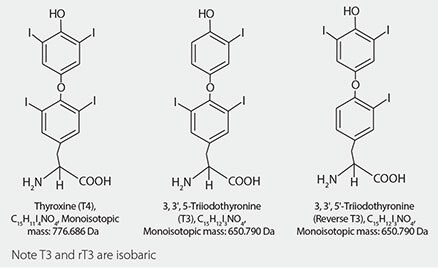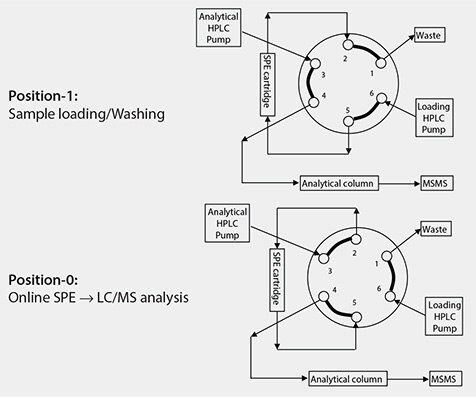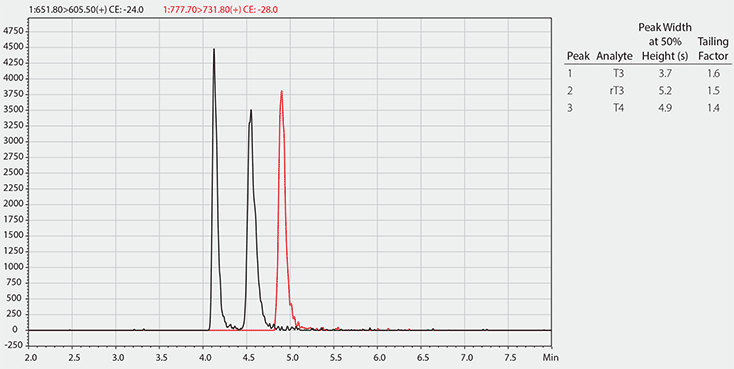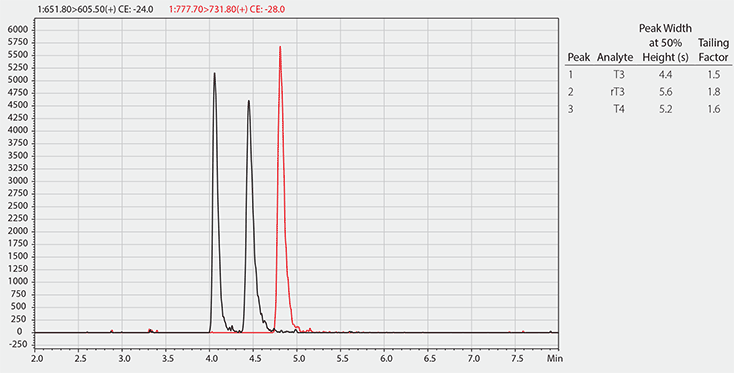Online Solid Phase Extraction and LC/MS Analysis of Thyroid Hormones in Human Serum
Introduction
Thyroid hormones play critical roles in the regulation of biological processes, such as: growth, metabolism, protein synthesis, and brain development. Specifically, both 3,3’,5,5’-tetraiodo-L-thyronine (thyroxine or T4) and 3,3’,5-triiodo-L-thyronine (T3), are essential for development and maintenance of normal physiological functions. For a clinical laboratory, measurements of total T4 and total T3, along with estimates of free T4 (FT4) and free T3 (FT3), are important for the diagnosis and monitoring of thyroid diseases. Most clinical laboratories measure thyroid hormones using immunoassays. The immunoassay-based methods offer a relatively rapid, high patient sample throughput that lends itself to automation, but are significantly compromised by problems with assay interference and are complicated by changes in protein levels that alter the free hormone availability.1
Liquid chromatography mass spectrometry (LC/MS) has been reported to offer superior specificity and speed over the immunoassays for determination of thyroid hormones in biological matrices such as serum and tissues. Nevertheless, the reported sample preparation procedures, typically liquid-liquid extraction followed by solid phase extraction (SPE), involve multiple time consuming steps, and are less compatible with automation.2,3 The present work demonstrates successful online SPE with LC/MS for rapid determination of T4, T3, and 3,3',5'-triiodo-L-thyronine (rT3) from biological matrices.
Experimental
Materials: Supel™ Genie C8 and RP-Amide (RPA) online cartridges (2 cm × 4.0 mm I.D.), human serum (Product No. H-1388), protein precipitation solvent: methanol with 1% (w/v) ammonium formate.

Figure 1:Chemical Structures of the Thyroid Analytes
Figure 1. Chemical Structures of the Thyroid Analytes
Sample Processing Procedure: the human serum spiked with analytes was protein precipitated by vortex mixing with the precipitation solvent at a 1:3 ratio. Then the mixture was centrifuged at 10,000 x g for 3 min and the resulting supernatant was collected and directly injected for LC/MS analysis.
Online SPE-LC/MS Setup: As shown in Figure 2., the online SPE-LC/MS setup consists of a 6-port switching valve and two pumps; one for sample loading and washing, the other for sample elution. To minimize the potential peak broadening from the cartridges, the flow of sample loading/washing and the subsequent elution are in reversed directions.
Conditions for Test

Figure 2:Configuration of the Online SPE-LC/MS System
Results and Discussion
The conventional (off-line) sample preparation by SPE typically involves multiple labor-intensive and time-consuming steps, including: conditioning, sample loading, washing, elution, and finally evaporation and reconstitution of the sample in mobile phase. The Supel™ Genie C8 and RPA online cartridges have been developed to automate the sample preparation process, minimize hands on time and human error, and reduce overall sample processing time. The present work utilized the C8 and RPA online cartridges with LC/MS for the detection of thyroids from human serum. Figures 3 and 4 shows the representative LC/MS chromatograms of T3, rT3, and T4 spiked in human serum with C8 and RPA online cartridges, respectively. The human serum samples were simply protein precipitated with methanol containing ammonium formate and then directly injected for online SPE and LC/MS analysis. The sample loading/washing were carried out entirely by the instrument, without any hands-on effort. Additionally, the time-consuming solvent evaporation and reconstitution steps were eliminated.
As can been seen from Figures 3 and 4, both C8 and RPA were capable of capturing a trace amount (100 ng/mL x 2 μL in this case) of thyroids from complicated human serum. All three thyroids are resolved from each other, with a peak width at half height <6s and tailing factor from 1.4-1.8. The total run time is within 6 min.
Tables 1 and 2 show the ruggedness of the online SPE-LC/MS with C8 and RPA cartridge, respectively, from 120 consecutive injections of the human serum samples. As can be seen, the retention times of the thyroid analytes with C8 or RPA are very reproducible, with RSD’s of 0.1%-0.2%. The reproducibility (RSD%) of the peak area of the thyroid analytes with C8 and RPA cartridges is 6.2%-7.0% and 5.1%-7.7%, respectively, which indicates great precision.
Comparing the two online cartridges, RPA appears to deliver greater signals (peak height and area) for all three thyroid analytes compared with the C8 cartridge. The mechanism behind this is not clear, however, the RPA is known to offer better retention for analytes with polar moeity groups which form hydrogen bonds. Otherwise C8 and RPA provide similar results in terms of peak shape and reproduciblity of peak area.

Figure 3: Representative LC/MS Chromatogram of Thyroids in Human Serum with C8 Online Cartridge

Figure 4:Representative LC/MS Chromatogram of Thyroids in Human Serum with RPA Online Cartridge
Table 1. Ruggedness of the System with C8 Cartridge |
|---|
Table 2. Ruggedness of the System with RPA Cartridge |
|---|
Summary
An online SPE-LC/MS method has been developed for the rapid detection of thyroid hormones in human serum with minimal handson effort and time-consuming steps. Both C8 and RP-Amide online cartridges were shown being capable of capturing a trace amount of thyroids from protein precipitated human serum samples. All three thyroid analytes, T3, rT3 and T4 were resolved on a Biphenyl column, with sharp and symmetric peak shapes. In addition, reproducibility (RSD%) of the retention time of the thyroids from 120 consecutive injections is between 0.1% and 0.2%, with either C8 or RPA online cartridges, while the peak area reproducibility (RSD%) is between 5.1% and 7.7%. These RSD’s indicate great ruggedness of the online SPE-LC/MS system.
References
如要继续阅读,请登录或创建帐户。
暂无帐户?